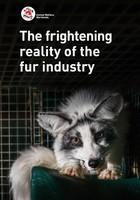
Real or Faux? be careful of deceptive fur labels
FOUR PAWS fur investigations reveal mislabelling and deceitful practices, with tips on how you can spot the difference
Australia imports millions of dollars’ worth of real and faux fur products each year, a portion of which have been found to be mislabelled as faux when they are in fact real fur. Australian fur imports often include less expensive fur items, such as trims on clothing, accessories, souvenirs, and children’s toys.
FOUR PAWS investigations have exposed mislabelled fur products across NSW and Victoria, deceiving Australian consumers and highlighting an alarming lack of transparency and traceability in fur supply chains. The investigations found that real fur items were deliberately mislabelled as ‘faux’, or as being from a different species than what DNA tests revealed. Indeed, deceptive labelling is a worldwide problem, and it has been found that products are deliberately mislabelled when exported to countries where there is local opposition to fur.

Investigation shows real fur labelled as ‘faux’ in Australia
Our joint investigations with the Animal Justice Party in Victoria exposed mislabelled and unlabelled fur products in Australia.
Victoria:
In 2019, 12 items featuring fur or fur-like material were collected from two Melbourne markets. The fur items were sent for microscopy testing at Forensic Science and Wildlife Matters, which provides expertise and advice to law enforcement authorities, conservationists, and the public. The results were shocking, including:
- One jacket with a fur trim which was labelled as “100% polyester”, but testing confirmed the hairs were from a raccoon or raccoon dog.
- One garment labelled "Brim and Brawn 100% rabbit blend", but test results found "the appearance of the medulla and the shaft of hairs in this item indicated that they are inconsistent with rabbit ... but consistent with raccoon ... or raccoon dog".
- One item had no label at all, but testing revealed it had fur from a rabbit.
- One garment was labelled with “Husk Mystic Leather", but the forensic testing instead found that the material was made from hairs, and not synthetic fibres, yet due to the heavy colour dyeing, the animal species could not be identified.
A follow up investigation in 2020 revealed similar results, with mislabelled fur items discovered at the same markets.
New South Wales:
In 2020, FOUR PAWS collected 11 samples including scarves, jackets, handbags, and gloves, from both online and market retail outlets across Greater Sydney.
The samples were submitted for laboratory testing, which included microscopic examination and a comparison with other samples to determine species. Even based on a small-sample investigation, products found were either mislabelled, had no label, or the vendors gave inaccurate information. Of the 11 samples:
- Eight items had no labels at all.
- One item was claimed to be faux fur by the vendors, but forensic testing revealed it was animal fur.
- Four items were made of different animal fur than claimed by label or vendor.
- Fur from three species were identified via testing, these were rabbit (found in seven items), fox (found in three items), and raccoon dog (found in one item).
- There was little to no information on all the products tested as to the origin of the animals used.
Globally: Mislabelling has also been exposed in the UK, the EU and the US, we can look to these similar jurisdictions for guidance on what we can do here to combat the same problem.
What are we doing about it?
FOUR PAWS Australia has provided a detailed review of the current regulations of fur sales in Australia and recommendations for how we can end the sale of fur, for a fur free future. Read our latest report here.
real or faux: tips to spot the difference
So how can you be sure that you made the right ‘faux’ choice? For conscious consumers who want glamour without cruelty, here are four handy hints to ensure your furry attire is of the Wear it Kind variety.
The underwool test
Pull the upper hair of the fur slightly apart and see if you can detect the underwool. It's made of fine, dense and fluffy hairs that keep animals warm in freezing temperatures.
the leather test
Real fur is processed together with leather. Pull the hairs carefully apart. You should be able to tell whether the material underneath is woven fabric or leather.
the wind test
Real fur moves in the slightest breez. Blow very gently over the fur and if the hairs move, it probably came from a furry creature.
the scent test
Not to be tried in the store of course, but real hair will react very differently to a flame than imitation hair. If they crumble and you can smell burnt hair or skin, it's real.
Imitation fur gives off an artificial scent when burnt. These fibres melt into small hard lumps rather than ash.
The Fur Free Retailer program
Did you know that FOUR PAWS is the official representative of the Fur Free Retailer program in Australia, Germany, Austria, Bulgaria and South Africa?
If you want to be sure that you’re not buying real fur by mistake, check the list of fashion labels with a fur-free policy published by the Fur Free Retailer initiative.



